What Is Cat Massage Therapy? Types, Pros & Cons
Updated on
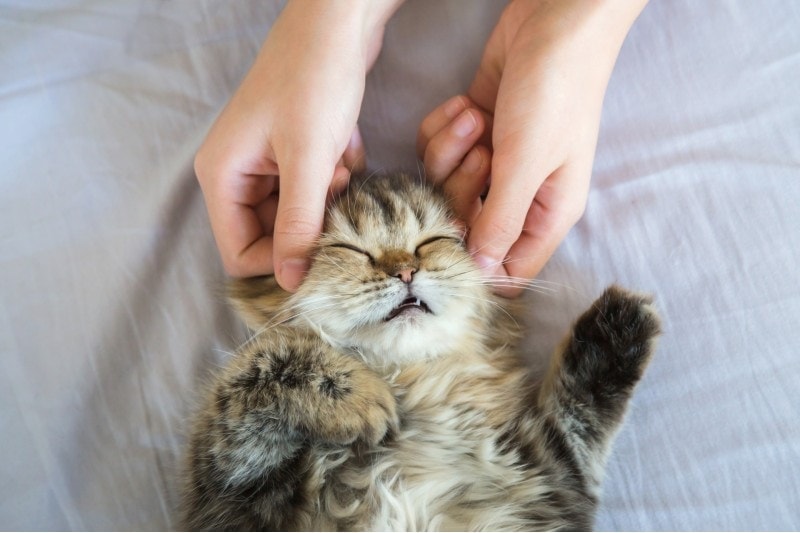
Cat massage can provide a range of benefits, both physical and psychological, to cats of all ages. Massage therapy is a gentle, non-invasive way of helping kitties stay healthy, relaxed, and comfortable. It can improve circulation, reduce stress, and even help cats recover from illness or injury. It is also a great way to bond with your feline friend and even reduce problem behaviors. With the right training and technique, cat massage therapy can be a beneficial and enjoyable experience for cats and owners alike.
Read on to learn more about the different types of massage therapy for cats, how it works, the pros and cons, and how to do it without hurting your cat.
How Does It Work?
Cat massage therapy is a method of applying gentle pressure to the muscles, joints, and soft tissues of a cat’s body. It is a form of therapeutic touch that like massages for humans, can help relieve pain and improve the cat’s overall health. It is a technique that has grown in popularity in recent years. While many people think that massaging cats is tricky, it is actually an easy and enjoyable process when you know how to do it properly.
There are various techniques called “strokes” that you can use, depending on what your cat enjoys and what you want to achieve. Each type of stroke has a specific purpose and application.
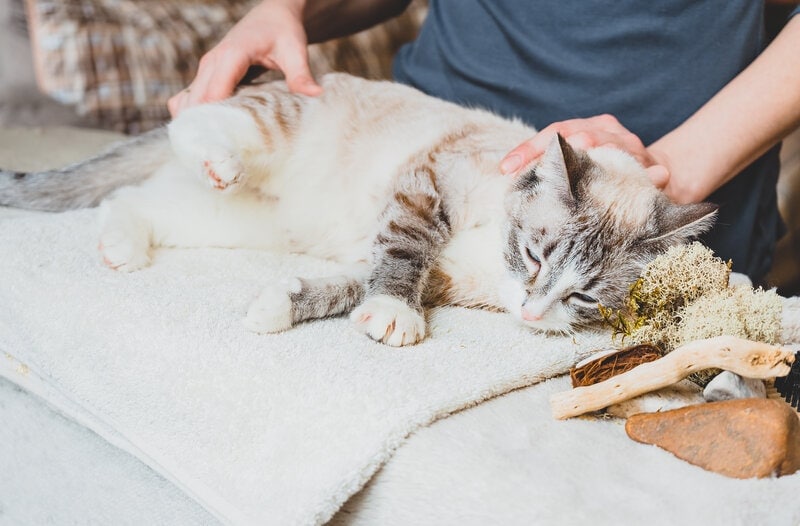
The 5 Different Types of Cat Massage Therapy
There are different techniques of therapeutic massage for cats that are inspired by human medicine. However, these methods can seem quite daunting if you don’t have experience in this area. Therefore, it is essential to seek the advice of a certified veterinary massage therapist before doing a massage session with your beloved pet.
1. Simple Stroking
Simple strokes are used at the beginning and end of a massage session to help relax the cat. They consist of stroking the cat from head to tail using light to medium pressure. This also helps assess areas of tension and detect any bumps, swelling, or temperature differences from area to area.
2. Effleurage
Effleurage is a French word that means a soft and light touch. This technique is performed with the whole hand and goes from the toes to the torso and from the back to the head. It’s particularly effective in relaxing muscles and helping to improve blood and lymph circulation. When properly administered, effleurage can help reduce swelling caused by the accumulation of fluid in the animal’s body.
3. Petrissage
Petrissage is a French word meaning “to knead.” In fact, if you like to make your own pizza, you are probably familiar with the action of kneading dough. This term is also used to refer to a deeper level of pressure in massage therapy. Petrissage can be used to relieve muscle tension, knots, and muscle spasms in your pet.
4. Skin Rolling
Skin rolling is performed from the extremities of the limbs to the torso and from the tail to the head. This technique, often highly appreciated by cats, also serves to improve blood and lymph circulation.
5. Concussive Stroke
You may want to let a certified veterinary massage therapist perform this technique, as it can seem intimidating for those new to cat massage, though it is not as scary as the name suggests. It involves using moderate pressure on the cat’s body using the edge of your hand and fingers to perform quick movements over specific areas. Chopping, tapping, and tapotement are three types of movements used in concussive stroke, which help increase the circulation of blood and lymph.
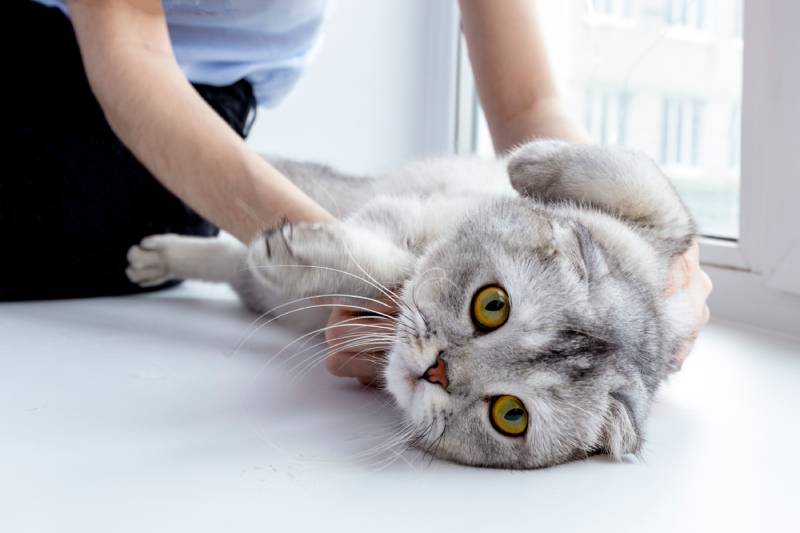
Where Is It Used?
Working with a certified veterinary massage therapist is your safest option when you’re just starting out. That said, there are basic techniques that you can learn so you can give your cat gentle massage therapy from the comfort of home.
Advantages of Cat Massage Therapy
While the benefits of cat massage therapy may not be scientifically proven, many experts in the field believe that this practice has many positive effects on cats. Due to our similar physiology and anatomy, the benefits seen from massage therapy in humans seem to be similar in felines.
For instance, cat massage can help reduce stress and anxiety, improve blood and lymph circulation, reduce scar tissue, increase flexibility, improve muscle tone, and reduce inflammation and pain associated with arthritis problems.
It can also help build trust between you and your pet while enabling you to identify potential issues (like a new bump in their skin or pain in their body that may be related to an underlying health problem).
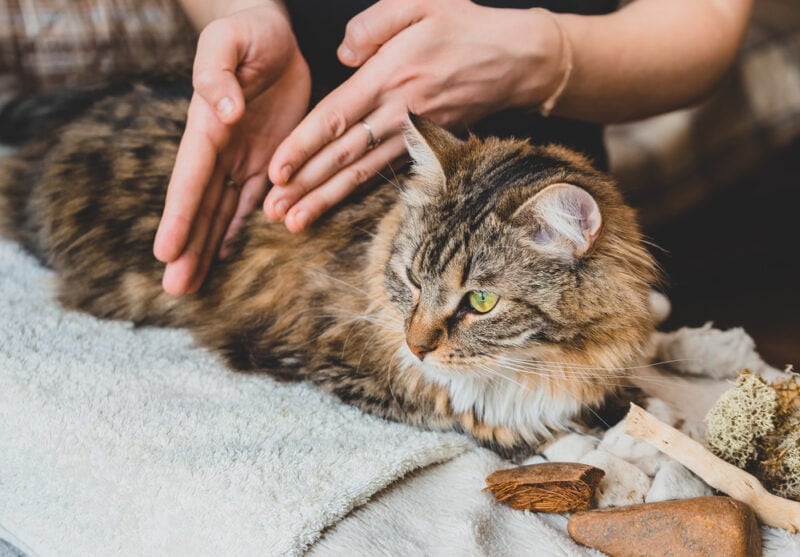
Disadvantages of Cat Massage Therapy
Although cat massage therapy is generally safe, some cats may be more sensitive to massage than others. It’s also essential to be aware of any injuries or health issues that your pet may have, as in some cases, massage can make their condition worse.
You should always consult your veterinarian before massaging your cat, especially if they have the following conditions:
- Open wound
- Broken bones
- Fever
- Skin infections
- Other health issues
How to Give Your Cat a Massage
Here are a few tips for giving your cat a gentle massage at home:
- Choose a time when your cat is calm and relaxed (for example, after a nap).
- Go to a quiet room in your house. You can use a yoga mat or their favorite blanket for extra comfort. Keep noisy children and other pets out of the room.
- Let your pet decide whether they want to lie down, sit down, or stand up.
- Start with a light and soft stroke. Massage their body with slow, gentle movements, and forget the more complicated techniques for now.
- Pay attention to your cat’s body language, and stop your massage if you notice any signs of pain or aggression.
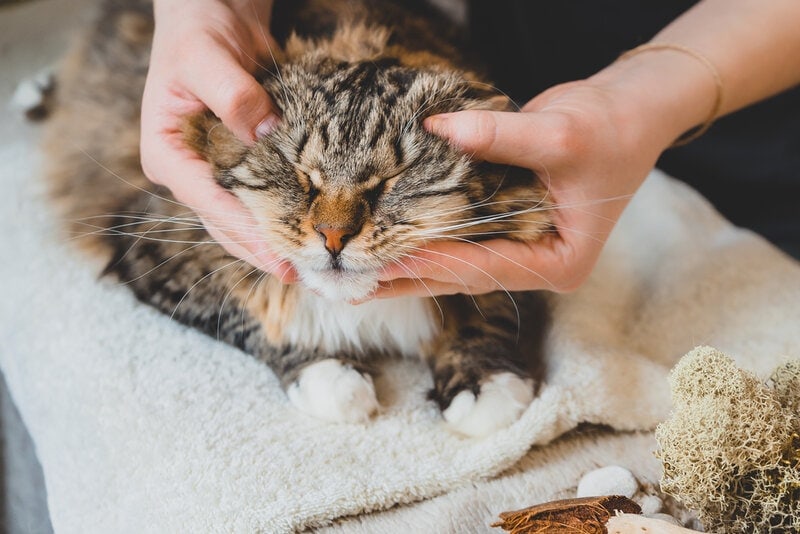
Frequently Asked Questions (FAQs)
How Long Should a Massage Last?
Basically, your cat will decide the duration of the massage session. As a proud cat owner, you already know that everything you do happens at their pace. So, your session can last anywhere from 10 minutes to an hour; it entirely depends on the temperament and tolerance of your feline friend.
How Often Should You Massage Your Cat?
Experts recommend gentle massages as often as needed, while the frequency of deep muscle massages should be established based on recommendations from a veterinarian or certified veterinary massage therapist.
How Do You Know If Your Cat Is Enjoying Your Massage?
Since cats are generally less expressive than dogs, it can be difficult to determine if they are enjoying your massage. However, a few signs are evident. For example, if your cat stays still, purrs, or falls asleep, you know that your massage is working!
Are Oils Necessary When Doing a Cat Massage?
No, you don’t need to use anything other than your hands to massage your cat, though certain essential oils are sometimes recommended to help calm and reduce anxiety. However, do not purchase any of these products without first consulting your veterinarian, as certain essential oils are toxic to cats and dogs.
Conclusion
Cat massage therapy is a growing trend that can provide a range of benefits, both physical and psychological, to our feline companions. It is usually a gentle, non-invasive way of helping cats stay healthy, relaxed, and comfortable. Moreover, cat massage can help ease aches and pains, relax tense muscles, improve blood and lymphatic circulation, and reduce stress. It can also be used to treat joint pain and stiffness (particularly in older cats) and strengthen your bond with your pet.
If you’re interested in learning more about cat massage therapy, start by asking your vet or looking for a certified veterinary massage therapist in your area. This way, your cat can benefit from these techniques in the comfort of your home!
See also:
- 12 Dogs With the Best Sense of Smell According to Science
- 11 Helpful DIY Porch Potties You Can Make Today (With Pictures)
Featured Image Credit: Gumpanat, Shutterstock










